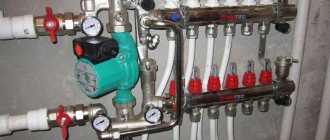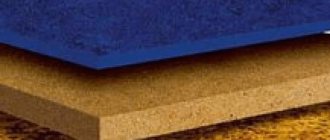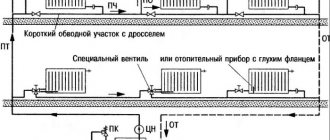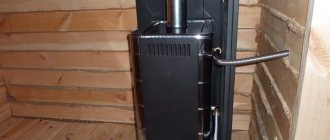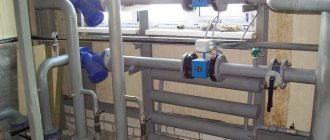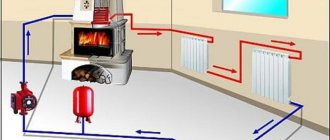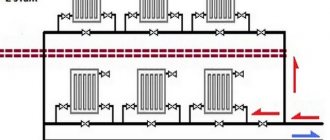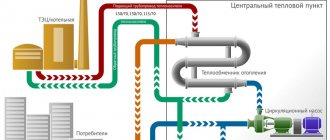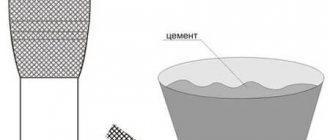Features of heating with radiators
All apartments have radiators; these are quite efficient devices that will require heaters only during the off-heating season. Of course, in a private house with individual heating there are no such problems - the residents themselves decide when to turn the heating on and off. But what about whether heating radiators are effective and practical in private homes in general? Or, following modern trends, is it better to give preference to heated floors?
Correct installation of the radiator
Connection diagrams for heating radiators
There are only 3 such schemes, each of them has its own characteristics, pros and cons.
Diagonal connection from 12 radiator sections
Option #1. Single-pipe
Here the radiators are connected in series, making installation much easier and requiring much less consumables. A pipe running under the radiators goes from the boiler through all the rooms and returns to it. The radiators are connected via lower pipes. The liquid fills the sections of the batteries, giving them heat, falls and goes through another pipe into the same pipe.
Video - Advantages of single-pipe heating systems
As for the disadvantages of the scheme, these include, first of all, rather low heat transfer, because the coolant in this case enters each battery after it has already cooled down. As a result, the further the room is from the boiler, the colder it will be.
Option #2. Two-pipe
There are 2 pipe circuits here at once - through one the coolant is supplied to the radiators, and through the other it is removed, due to which the thermal energy is distributed evenly throughout the house.
Note! This scheme has many advantages, since each individual room can provide its own temperature regime. And if repairs are required, there is no need to turn off the entire heating system. In a word, the scheme is much better than the one described above.
Video - Connecting radiators in a two-pipe system
About methods of connecting pipes to radiators
How effective such heating will be largely depends on the way the batteries are connected to the pipeline. There are several of these methods; let’s look at the features of each of them.
Table. How batteries are connected to heating pipes.
| Connection method | Short description |
| Lateral | The supply and return are connected on one side of the heating device (top and bottom, respectively; you can swap them, but the heating efficiency in this case will decrease by approximately 7 percent). |
| Lower | Can be used in both one- and two-pipe systems. Experts believe that this is the most ineffective method. |
| Diagonal | The supply is connected from above on one side, and the “return” from below on the other. The best method if we consider it from the point of view of heat transfer efficiency. |
How to connect a radiator to pipes
A few more words about radiator heating
Due to the fact that heated air rises upward due to the laws of physics, the air temperature near the ceiling and next to the radiators can be quite high. In other words, heating will occur in areas that do not really need to be heated. But the floor temperature in this case will be only 16-17 degrees, that is, not the most comfortable for the feet. We conclude: with radiator heating, heat is distributed irrationally.
Operating principle of radiator heating
The air that passes through the batteries is warmed up and distributed throughout the room. Simply put, it circulates, and dust rises with it.
On a note! For radiator heating, it is very important to correctly calculate the number of sections for each device. After all, each section can heat only a limited area and the efficiency of the entire system depends on the number of sections in the batteries.
Video - Arrangement of a radiator heating system
What are heated floors
Heated floors
Underfloor heating is characterized by laying pipes under the floor covering that provide heat. Such heating can be of several types - water or electric, depending on the heat carrier. Each of them has both advantages and disadvantages. But in general, the system is extremely popular due to a number of its advantages.
It should be noted that in this way you can warm up the room at any time of the year and regulate the thermal regime at will. Some use this method throughout the entire house, while others prefer to install heated floors partially, for example, in a children's room or bathroom.
Advantages
It is worth noting that this system is popular precisely due to its simplicity and efficiency:
- comfort that will not allow you to experience radiator heating, since you cannot walk on a heated floor with it in the winter season
- easy maintenance, since there are no radiators that need to be cleaned of dust
- this system provides almost uniform heating of the room, especially if it is not large in size
- due to the fact that the temperature below is warmer and the temperature above is colder (since heating comes from the floor), a minimum amount of heat comes out through the ceiling
- since the feet warm up first, a person immediately feels warm
- This heating does not dry out the air in the room
- When compared with heating costs of other systems, heated floors are 20-30% more economical
It is worth noting that the coolant for this system does not need to be heated as much as when circulating in batteries, so underfloor heating is the most economical option for operation. Many people are interested in whether underfloor heating can replace heating. The fact is that it is impossible to specifically answer this question; it all depends on the room. For example, a one-room Khrushchev house can be heated this way, but a private house with two floors cannot.
Disadvantages
Screed for heated floors
Along with a lot of advantages, we need to talk about the disadvantages so that there are no “surprises” later:
- if there is high heat loss in the room, there is no point in installing a water or electric floor, since the air will still remain unheated
- not all houses will be able to install such heating due to the peculiarities of the central heating pipes
- a heated floor system requires large material costs during installation, since you need to make a screed 10-15 centimeters above the pipes
- the system itself is more expensive than the radiator
- impossibility of repair: if you need to replace the pipe, then you will have to remove the entire structure along with the floor covering and screed
Taking into account all of the above, before installing this type of heating, it is recommended to weigh all the pros and cons so as not to make a mistake.
Popular types of heating radiators
| Photo | Name | Rating | Price | |
| #1 | Aluminum | ⭐ 99 / 100 | More details | |
| #2 | Bimetallic | ⭐ 98 / 100 | More details | |
| #3 | Steel | ⭐ 97 / 100 | More details |
Aluminum
pros
- the most energy efficient type;
- low susceptibility to coolant;
- low susceptibility to corrosion;
- a light weight.
Minuses
- Suitable only for individual heating systems.
Heating radiator Global
Bimetallic
pros
- high heat transfer;
- increased strength;
- a light weight;
- neutrality to the chemical composition of the coolant.
Minuses
- high price.
Heating radiator Rifar
Steel
pros
- average energy efficiency;
- varied performance;
- fast warm-up;
- affordable price.
Minuses
- susceptibility to corrosion.
Heating radiator Purmo
Features of heating with heated floors
The technology of heating underfloor heating appeared not so long ago, but is gaining more and more popularity every year. However, before installing such a system, understand everything in order to understand whether it is advisable. And in view of the fact that boilers are usually installed in private houses, attention should be paid specifically to water heated floors.
Features of a water floor system in a private house
Installation of heated floors
In essence, such systems are pipes on top of which a floor covering is laid. Heating occurs thanks to the coolant that circulates through these pipes. There are several piping installation methods, and with each method, the efficiency of the heating system varies depending on operating conditions.
Installation of water heated floor
What laying schemes are there?
So, the pipeline can be laid in the following ways:
- snail (the pipeline is laid in a spiral);
- snake (the contour is laid in zigzag turns).
Schemes for laying pipes for water heated floors
It is believed that snail laying provides better heating of the floor. But here it is important to lay the pipes with the correct pitch, which depends on the required heating intensity. Near windows and external walls you can reduce the pitch between turns, and closer to the center you can increase it.
Operating principle of water heated floor
Prices for mats for water heated floors
mats for water heated floors
How are heated floors heated?
When using heated floors, there is a rational distribution of air temperature. The entire floor area is heated evenly, while its temperature does not exceed 26 degrees, which is quite comfortable for the feet. At head level the temperature is already about 22 degrees, and at the ceiling it is the lowest. Moreover, it is not convection that takes place here, but thermal radiation, so the settled dust does not rise upward.
Calculation of the power of a warm water floor
When installing heated floors, you do not need to take into account the interior of the room, because the floor covering will hide all communications. But the main advantage is that in hot weather air conditioning is not required, since the heated floor can be made cold if necessary.
Master Class. Laying water heated floors
First, let's look at some important points. The length of the contour, as we found out above, depends on the area and the chosen installation scheme. If the room is large (from 30 sq. m), then 2 or even 3 circuits may have to be installed in it. Moreover, they will warm up regardless of each other, even if they are connected to the same collector. As for the diameter of the pipes, the larger it is, the longer the length of the circuit will be. By the way, the pitch, length and diameter must be the same if the highways are connected to a single system.
Pipes for water heated floors
Heated floor pipe circuit length calculator
Go to calculations
Expert opinion
Afanasyev E.V.
Chief editor of the pol-exp.com project Engineer.
There is no need to lay pipes under built-in furniture, since they will be of no use there. Take this into account during calculations.
When laying, you need to retreat about 30 cm from the internal walls, and 10-15 cm from the external walls.
Well, now to the point! Let's see how a heated floor system with polystyrene foam slabs is installed, on top of which the screed will be poured. Plates are needed to fix the pipes to the base.
Step 1. First of all, prepare the subfloor - remove all debris and dust. Also remove everything unnecessary from the room. If minor defects are found on the base, then you can ignore them.
First, preparatory work is carried out
Step 2. After this, lay the waterproofing layer, and on top of it - insulation (in our example it is polystyrene foam). It is important that the individual strips of waterproofing are laid overlapping, and the joints are taped with good tape. Lay the slabs of thermal insulation material close to each other, trim them if necessary. As a result, the entire floor must be covered with slabs.
Laying insulation
Step 3. Apply damper tape around the perimeter, as shown in the photo. You can even fasten it with self-tapping screws, if the material from which the walls are made allows. With a damper tape, the screed will not crack when it dries and begins to expand. You should not refuse to use tape, because the quality of the floor will suffer because of it.
Attaching the damper tape
Step 4. Lay the polystyrene foam mats so that the protrusions of adjacent elements match. Lay mats over the entire floor area. They fit together easily, moreover, they can be cut if you need to cover small areas (smaller than the area of the mats themselves).
Laying polystyrene foam mats
The protrusions must match
If necessary, mats can be cut
Step 5. Thoroughly clean the mats of debris before starting to lay the heating circuit. And it (garbage) will definitely appear if the mats had to be cut.
Removing debris from mats
Step 6. The collector in our example is located in the next room, and therefore the pipes need to be brought there. For this purpose, you can drill a hole in the wall through which you can stretch these pipes. In addition, make another hole nearby - you will insert the second end of the pipe into it (to supply the cooled coolant back into the system towards the collector).
A hole is being drilled
The pipe is inserted into the hole
Pipe outlet in the next room
Step 7. Lay the pipes according to the chosen pattern (in our example, they are laid in a snail pattern) in accordance with the step, using the protrusions of the mats for fixation. In the center of the room, run the pipes in the opposite direction, then insert the end into the second hole made. Before you start pushing, wrap the end of the pipe with tape so that nothing gets inside.
Pipe laying process
Another photo of the process
The end of the pipe is wrapped with tape
Step 8. After laying and connecting the pipes to the manifold, fill the system and check it for functionality. Then pour the cement screed. By the way, before pouring the screed, do not drain the water from the system - this will prevent the contour from deforming under the weight of the concrete.
Next you can pour the screed
A laser level is used for work
Step 9. In a large room, pre-install beacons to align the screed with them. To level, use a long rule, resting it on the beacons and removing excess mortar to create a smooth cement surface.
Screed alignment
Step 10. Then, when the screed has set a little, grout it. After this, wait at least 28 days for the screed to completely dry. Before this, do not turn on the heated floor under any circumstances! And after 28 days, lay the flooring.
Grouting screed
Advantages and disadvantages of water heated floors
Advantages of a warm water floor
- When using this type of heating system, the principle of radiation rather than conversion will be used. In this regard, several important advantages of water heated floors appear at once: active circulation of dust when moving air masses is eliminated.
- There are no areas of high dampness, and therefore a reduction in the likelihood of fungus appearing.
- Among the advantages of water heating, many users note that it does not require additional maintenance; there are no difficulties in removing dust, unlike radiators.
- An important advantage of warm water floors over radiators is complete safety, eliminating the possibility of burns even with prolonged contact with a heated surface.
- The heating system makes it possible to completely remove equipment from visibility.
- An important advantage of a warm water floor is its compatibility with any other types of systems, which allows you to find an individual solution in each individual case.
- Savings on heating costs when using such a system range from 20-30% compared to a radiator system.
- All types of water heated floors in terms of their service life are limited only by the time of use of the pipes used in the formation of this system.
- During operation of the system, self-regulation of the heat exchange process in the room occurs: heat transfer depends entirely on the temperature in the room.
- There are no health disadvantages or any negative consequences found with the use of water heated floors.
Disadvantages of water heated floors
- There is no way to effectively use the technology in rooms where a large area is occupied by stairs. You will need to use heated floors in combination with radiators.
- There is a common misconception that the advantage of water heated floors is that it slightly reduces the level of humidity in the room. In fact, such a system dries out the air much more than a traditional radiator system, so purchasing an air humidifier will become a necessity.
- The installation of a water system in apartment buildings is not allowed due to a significant increase in hydraulic resistance.
- Installation is quite complicated and can only be done during a major renovation of the premises.
- If you choose between water or infrared heated floors, it is important to consider that using the first option always leads to a significant increase in the floor level. For the construction of infrared systems, polyester film fabric with a thickness of 100 microns is used.
- There is a possibility of a leak that will require quite complex repairs.
So which system should you choose?
From a savings point of view, heated floors, of course, win. After all, if for radiator heating it is necessary that the temperature of the working fluid be somewhere around 70 degrees, then for a warm floor this figure is only 40 degrees.
Scheme of the compiled calculations of the contours of a water heated floor
When installing a heated floor, it is important to correctly calculate the length of the contour and the pitch between its turns. If the step is minimal, the floor will heat up too much. To eliminate this problem, you can reduce the temperature of the working fluid, but such a move is not economically viable.
With the length of the circuit, everything is the same: if it is too long, then there will be no question of effective operation of the system. And this is much more difficult to fix, because heated floors, as a rule, are filled with cement screed.
Heating installation in a private house
Note! If the number of radiator sections is insufficient, they can be added, if this is, of course, provided by the manufacturer. Alternatively, you can install a new battery.
Choosing a floor covering for a warm floor, as well as arranging furniture, must be done very carefully. It is important that the material conducts heat well and does not emit harmful substances when heated. As for the arrangement of furniture, this point needs to be thought through at the design stage.
As a result, we note that the efficiency of a heating system (of one type or another) depends on how well the house is insulated, and on the correct calculation of the devices taking into account the heated area. If heat loss is small, then a heated floor - properly designed and installed - will be effective. And if the heat loss is large, then it is better to give preference to radiator heating or, as an option, use a combined option.
Which heating is better: warm water floor or radiators
Which is better, a warm water floor or radiators?
In most cases, the choice of heating system is between a water heated floor or radiators. In order to decide, it is enough to compare both options according to several key characteristics, which will allow you to evaluate all the possibilities, pros and cons of the technologies.
Economical
This is one of the most important issues, which in the future will determine the amount of annual/monthly heating costs. If we compare both options for the distribution of hot air flows in the room, it turns out that the greatest heat from the battery remains next to it. Heating from the heated floor occurs throughout the entire area of the room.
Batteries are always installed under a window to avoid intense condensation. But this same decision causes intense heat loss to occur in the same zone. In addition, if the walls are insufficiently insulated due to the high temperature difference, the situation is aggravated.
Also, the efficiency of using a heated floor is increased due to the fact that during its operation the concrete slab is heated, which becomes a powerful source of heat, and the radiator can only act on the nearby air. As a result, savings when using heated floors average up to 30%.
Which is cheaper: water heated floors or radiators?
In this case, much depends on the area of the premises and the installed equipment. But due to the large amount of work involved in installing concrete screeds, hidden laying of pipelines, and the need to attract specialized specialists to perform such tasks, the cost of equipment and its installation when using a radiator system will be lower.
Inertia
The rate at which the room heats up when the heating is turned on is an important issue that largely determines the degree of comfort in using the system. In this case, deciding whether a warm water floor or radiators is better will not be easy. The peculiarity of the first option is that, for objective reasons, it will take longer to heat up a concrete slab than a radiator exposed to air. But at the same time, cooling when the heating is turned off using a heated floor will occur much more slowly. In this regard, the decision about whether this is a plus or a minus of water heated floors can only be made by the user himself.
Maintainability
The main problem in this case becomes the issue of accessibility of installed equipment and pipelines. For water heated floors, this is a minus, but at the same time, provided that the equipment is properly selected and the system is correctly designed and installed, the service life of hidden heating without the need for repairs will be equal to the service life of the pipes. That is, on average, you won’t have to open the screed for about 50 years. Equipment based on radiators is always open to access, but at the same time it requires repairs much more often.
There are many arguments in favor of each option, but the optimal solution in most cases is to use a combined system using both technologies. At the same time, all the pros and cons of warm water floors and radiators will be taken into account and used so that in the end the project will only benefit from their joint use.
